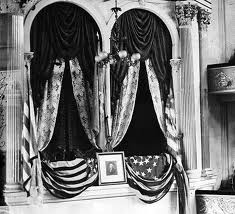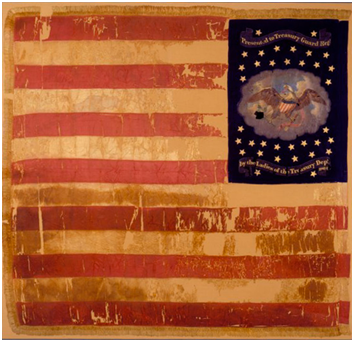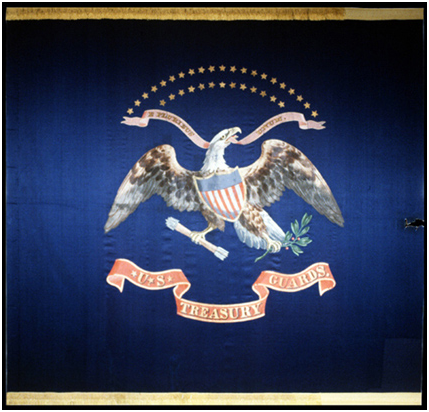The Flag and Lincoln’s Assassination

The Presidential Box at Ford’s Theater decorated for Lincoln’s visit on April 14th of 1865.
It has been close to a century and a half since Abraham Lincoln died at an assassin’s hand, and Americans have heard the retelling of John Wilkes Booth shooting the president at Ford’s Theater so many times that it has become a familiar story. Yet when Abraham Lincoln died on the morning of April 15th in 1865, the nation was plunged into grief and mourning unparalleled in our nation’s history. His assassination, happening as it did on Good Friday, became part of transforming the man into a martyr and national saint. Every detail of the events surrounding the president’s death was examined for significance as his countrymen struggled to give the event meaning. Stories circulated about every detail, some of them true and some myth. Even the flags decorating the presidential box became part of the history, story and legend, and the association of these flags gave new significance to the Stars and Stripes almost as religious relics.
Flags decorated the presidential box at Ford’s Theater that night. Some stories claim that the theater’s manager had to scour the city for flags for an appropriate display when he learned the President and Mrs. Lincoln would attend the evening performance on April fourteenth. The war had just ended, so it is possible that a special show of patriotic decorations seemed especially appropriate. Yet, Lincoln regularly attended theatrical performances and it may not have been that unusual to prepare the box for the president and his party.
There were five flags displayed and draped from the presidential box when Lincoln arrived, three United States flags and two U.S. Treasury Guard flags. The two Treasury Guard flags and one of the U.S. flags are believed to still exist, and are held in museum collections. The whereabouts of the other two U.S. flags, if they still exist, are unknown.

One of two Treasury Guard Flags displayed at Ford’s Theater when Lincoln was assassinated.

This Treasury Guard flag has a tear in its edge that may have caught Booth’s spur as he jumped from the Presidential Box.
While the Treasury Guards were not part of the military, their flags were similar to the National and Regimental Colors carried by the U.S. Army. One looked like a regular U.S. flag, except the union included an eagle with the stars in the blue canton. The second flag had a blue field with the same bald eagle and stars found in the union of the first flag. Had Treasury Guards carried the flag into the theater that night, Booth’s plan may have been thwarted. However, Lincoln’s sole guard, a Washington metropolitan police officer, left his post outside the entrance to the box to enjoy a beer at a neighboring tavern.
Perhaps this is the reason some believe that the flags, while unable to protect Lincoln, at least exacted revenge on his escaping assassin. After Booth shot the president he vaulted from the presidential box to the stage below to make his escape. In the jump, Booth’s spur caught the edge of one of the Treasury Guard flags throwing the actor off balance, and he landed wrong breaking his ankle. Most historians agree that this actually happened, and the Treasury Guard flag has a tear along its edge that would support this story. Still, as is often the case, there are those who say the story is romantic myth.
When Booth landed on the stage he is said to have cried out, “Sic semper tyrannis”, a Latin phrase meaning “thus always to tyrants.” The motto is found even today on the state flag of Virginia.
The truth of the stories surrounding the one existing U.S. flag said to have been displayed in Ford’s Theater is harder to verify. It is a flag with human blood stains found in Pikes County (Pennsylvania) Historical Society Museum that is said to have comforted the dying president.
Lincoln by some accounts was said to have grabbed the flag when he fell forward after being shot. However, most accounts fail to mention this detail. If it did happen, it was not documented by those who were there.
Laura Keene, the star of the evening’s play is said to have gained entrance to the president’s box carrying a pitcher of water and “some stimulants,” and there she is said to have held Lincoln’s head in her lap cushioned with the U.S. flag she pulled down from the decorations. Some versions of the story even claim that the flag was used to cover the president like a blanket as he was carried across the street to the room where he died the following morning. The actress’ presence in the box is mentioned in some accounts, but the claim that the flag was used to comfort the dying president is unproven, but steadfastly claimed by proponents.
Why tell these stories if their validity is questioned? These stories show how the United States flag has been transformed from a national symbol used mainly by the government and the military into a sacred emblem embraced by the citizenry. Before the U.S. Civil War, the U.S. flag did not have the emotional impact with Americans that we know today. Soldiers carrying the flag into battle, and the witnesses of events like Lincoln’s assassination created new meaning for the Stars and Stripes. The crucible of the Civil War gave new meaning to the flag. The meaning of the flag today grew from the stories of our nation. The Lincoln assassination is a part of that story, and how it was viewed and is viewed has influenced our attitudes toward the flag.
